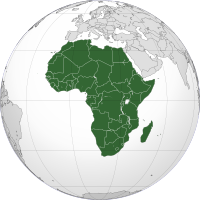
Photo from wikipedia
Abstract Despite its potential linkages with North Atlantic climate, the variability in Saharan dust transport to the western North Atlantic over the past two millennia has not been well-characterized. A… Click to show full abstract
Abstract Despite its potential linkages with North Atlantic climate, the variability in Saharan dust transport to the western North Atlantic over the past two millennia has not been well-characterized. A factor of 4 increase in dust production in sub-Saharan Africa has been attributed to the onset of Sahelian agriculture 200 yr ago. The regional extent of this anthropogenic dust increase, however, remains uncertain. Additionally, while millennial-scale cold periods of the last deglaciation have been associated with strong increases in North African dust emissions, few adequate records exist to observe dustiness during the Little Ice Age, a century-scale cooling of the North Atlantic (AD 1400–1800). In this study, we develop a new technique for the paired use of 230 Th-normalized 232 Th fluxes and 3 He-normalized 4 He fluxes in Bahamian tidal flat sediments. After justifying the fact that 230 Th and 3 He have had relatively constant sources to tidal flat and banktop waters, and accounting for the smoothing effect of bioturbation, a factor of 4 change in far-field dust transport to the western North Atlantic between the pre-industrial and modern era is not supported by our dust proxies over the past 2000 yr. Furthermore, we speculate why the response of western North Atlantic dust deposition associated with the Little Ice Age climate anomalies may have been modest compared to prior climatic events of the early Holocene or the last deglaciation.
Journal Title: Earth and Planetary Science Letters
Year Published: 2017
Link to full text (if available)
Share on Social Media: Sign Up to like & get
recommendations!